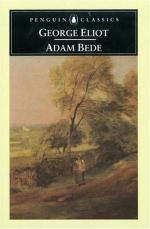Such men, happily, have lived in times when great abuses flourished, and have sometimes even been the living representatives of the abuses. That is a thought which might comfort us a little under the opposite fact—that it is better sometimes not to follow great reformers of abuses beyond the threshold of their homes.
But whatever you may think of Mr. Irwine now, if you had met him that June afternoon riding on his grey cob, with his dogs running beside him—portly, upright, manly, with a good-natured smile on his finely turned lips as he talked to his dashing young companion on the bay mare, you must have felt that, however ill he harmonized with sound theories of the clerical office, he somehow harmonized extremely well with that peaceful landscape.
See them in the bright sunlight, interrupted every now and then by rolling masses of cloud, ascending the slope from the Broxton side, where the tall gables and elms of the rectory predominate over the tiny whitewashed church. They will soon be in the parish of Hayslope; the grey church-tower and village roofs lie before them to the left, and farther on, to the right, they can just see the chimneys of the Hall Farm.
Chapter VI
The Hall Farm
Evidently that gate is never opened, for the long grass and the great hemlocks grow close against it, and if it were opened, it is so rusty that the force necessary to turn it on its hinges would be likely to pull down the square stone-built pillars, to the detriment of the two stone lionesses which grin with a doubtful carnivorous affability above a coat of arms surmounting each of the pillars. It would be easy enough, by the aid of the nicks in the stone pillars, to climb over the brick wall with its smooth stone coping; but by putting our eyes close to the rusty bars of the gate, we can see the house well enough, and all but the very corners of the grassy enclosure.
It is a very fine old place, of red brick, softened by a pale powdery lichen, which has dispersed itself with happy irregularity, so as to bring the red brick into terms of friendly companionship with the limestone ornaments surrounding the three gables, the windows, and the door-place. But the windows are patched with wooden panes, and the door, I think, is like the gate—it is never opened. How it would groan and grate against the stone floor if it were! For it is a solid, heavy, handsome door, and must once have been in the habit of shutting with a sonorous bang behind a liveried lackey, who had just seen his master and mistress off the grounds in a carriage and pair.




